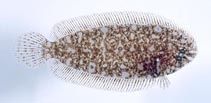| Family: |
Soleidae (Soles) |
| Max. size: |
7.45 cm SL (male/unsexed) |
| Environment: |
reef-associated; marine; depth range 14 - 48 m |
| Distribution: |
Northwest Pacific: Taiwan and Japan |
| Diagnosis: |
Dorsal soft rays (total): 68-75; Anal soft rays: 46-51. This species is distinguished by the following characters: D 68-75; A 46-51, all branched; 73-76 lateral-line scales; 36-38 vertebrae; dorsal pterygiophores anterior to 4th neural spine 13 or 14 (only 1 with 13); body depth 2.45-2.65 SL; head length 4.5-4.65 SL; caudal-peduncle length 7.7 8.2 in head length; snout length 2.4-2.65 in head length; preorbital length 2.4-2.5 in head length; eye diameter 4.65-5.25 in head length; interorbital space narrow, 11.1-14.4 in head length; tubular anterior nostril reaching edge of eye when depressed posteriorly; longest dorsal ray 1.6-1.9 in head length; caudal fin 3.15-3.55 SL; pelvic fins reaching or nearly reaching base of 4th anal ray, 1.65-1.75 in head length, 9-16 cteni on scales, not projecting very far beyond scale margins; front edge of snout and ventral edge of head with 2 rows of lappet-like cirri; color when fresh light brown with irregular white and dark brown markings, a few white ones forming broken circles, while dark brown ones may border or partly encircle the white; 2 prominent white bands on snout and 3 extending downward from lower eye; fin rays with small dark brown spots (Ref. 74405). |
| Biology: |
|
| IUCN Red List Status: |
Data deficient (DD); Date assessed: 28 July 2020 Ref. (130435)
|
| Threat to humans: |
|
Source and more info: www.fishbase.org. For personal, classroom, and other internal use only. Not for publication.
